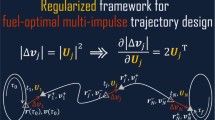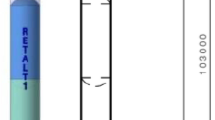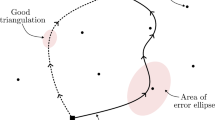Abstract
In a previous paper of Miele et al. (J. Optim. Theory Appl. 132(1), 2007), we employed the single-subarc sequential gradient-restoration algorithm to optimize the three-dimensional rendezvous between a target spacecraft in a planar circular orbit and a chaser spacecraft with an initial separation distance and separation velocity. The achieved continuous solutions are characterized by two, three, or four subarcs depending on the performance index (time, fuel) and the constraints. In this paper, based on the solutions in Miele et al. (J. Optim. Theory Appl. 132(1), 2007), we employ the multiple-subarc sequential gradient-restoration algorithm to produce pieced guidance trajectories implementable in real time via constant control components. In other words, in this investigation, we force the controls to behave as parameters in each subarc. With the above understanding, we investigate four problems: (P1) minimum time, fuel free; (P2) minimum fuel, time free; (P3) minimum time, fuel given; (P4) minimum fuel, time given.
Problem P1 results in a two-subarc solution, each subarc with constant controls: a max-thrust accelerating subarc followed by a max-thrust braking subarc. Problem P2 results in a four-subarc solution, each subarc with constant controls: an initial coasting subarc, followed by a max-thrust braking subarc, followed by another coasting subarc, followed by another max-thrust braking subarc. Problems P3 and P4 result in two, three, or four-subarc solutions depending on the performance index and the constraints, albeit with constant controls in each subarc.
For each of the problems studied, the performance index of the multiple-subarc pieced guidance trajectory approximates well the performance index of the single-subarc continuous optimal trajectory of Miele et al. (J. Optim. Theory Appl. 132(1), 2007) as well as the performance index of the multiple-subarc pieced optimal trajectory: the pairwise relative differences in performance index are less than 1/100.
Similar content being viewed by others
References
Miele, A., Weeks, M.W., Ciarcià, M.: Optimal trajectories for spacecraft rendezvous. J. Optim. Theory Appl. 132(1), 1–24 (2007)
Clohessy, W.H., Wiltshire, R.S.: Terminal guidance system for satellite rendezvous. J. Aerosp. Sci. 27(9), 653–658 (1960)
Miele, A.: Method of particular solutions for linear two-point boundary-value problems. J. Optim. Theory Appl. 2(4), 260–273 (1968)
Miele, A., Pritchard, R.E., Damoulakis, J.N.: Sequential gradient-restoration algorithm for optimal control problems. J. Optim. Theory Appl. 5(4), 235–282 (1970)
Miele, A., Tietze, J.L., Levy, A.V.: Summary and comparison of gradient-restoration algorithms for optimal control problems. J. Optim. Theory Appl. 10(6), 381–403 (1972)
Miele, A.: Recent advances in gradient algorithms for optimal control problems. J. Optim. Theory Appl. 17(5–6), 361–430 (1975)
Gonzalez, S., Miele, A.: Sequential gradient-restoration algorithm for optimal control problems with general boundary conditions. J. Optim. Theory Appl. 26(3), 395–425 (1978)
Rishikof, B.H., McCormick, B.R., Prictchard, R.E., Sponaugle, S.J.: SEGRAM: A practical and versatile tool for spacecraft trajectory optimization. Acta Astronaut. 26(8–10), 599–609 (1992)
Miele, A., Wang, T.: Multiple-subarc sequential gradient-restoration algorithm, part 1: algorithm structure. J. Optim. Theory Appl. 116(1), 1–17 (2003)
Miele, A., Wang, T.: Multiple-subarc sequential gradient-restoration algorithm, part 2: application to a multistage launch vehicle design. J. Optim. Theory Appl. 116(1), 19–39 (2003)
Miele, A., Weeks, M.W., Ciarcia’, M.: Rendezvous guidance trajectories via multiple-subarc sequential gradient-restoration algorithm. Paper IAC-06-C1.7.3, 57th International Astronautical Congress, Valencia, Spain (2006)
Supplementary References
Polites, M.E.: An assessment of the technology of automated rendezvous and capture in space. Technical Report TP-208528, NASA MSFC (1970)
Zimpfer, D., Tuohy, S.: Autonomous rendezvous, capture, and in-space assembly: past, present, and future. AIAA Paper 05-2523, 1st Space Exploration Conference: Continuing the Voyage of Discovery, Orlando, FL (2005)
Ianni, J.D., Graves, J.D.: The human’s dismissing role in future on-orbit servicing missions. AIAA Paper 2001-4539, AIAA Space Conference and Exposition, Albuquerque, NM (2001)
Matsumoto, S., Oda, M., Kawano, I.: Attitude dynamics and control of space cargo for reusable orbital logistic supply servicing. AIAA Paper 2002-4785, AIAA Guidance, Navigation, and Control Conference, Monterey, CA (2002)
Defense Advanced Research Projects Agency (DARPA), Orbital Express space operation architecture, website http://www.darpa.mil/tto/programs/oe.html
Air Force Research Laboratory (AFRL), XSS-11 Microsatellite, website www.vs.afrl.af.mil/FactSheets/XSS11-MicroSatellite.pdf
Anonymous: Executive summary (Introduction-CEV): NASA exploration system architecture study final report (draft) (2005), website http://www.spaceref.com/news/viewsr.html?pid=1967
Bailey, J.W.: NASA JSC Solicitation: commercial orbital transportation services (COTS) space flight demonstrations. NASA JSC Solicitation on Spaceref.com, website http://www.spaceref.com/news/viewsr.html?pid=18511
Dittmar, M.: Commercial avenues for space utilization. AIAA Paper 2003-6234, AIAA Space Conference and Exposition, Long Beach, CA (2003)
Long, A., Hastings, D.: Catching the wave: a unique opportunity for the development of an on-orbit satellite servicing infrastructure. AIAA Paper 04-6051, AIAA Space Conference and Exhibition, San Diego, CA (2004)
Pearson, D.J.: The glideslope approach. Paper AAS 89-162, Adv. Astronaut. Sci. 69, 109–123 (1989)
Fox, A.: Rendezvous crew training handbook. Manual TD398B, Mission Operations Directorate, Training Division, NASA-MSFC (1998)
Jezewski, D.J., Brazzel, J.P., Jr., Prust, E.E., Brown, B.G., Mulder, T.A., Wissinger, D.B.: A survey of rendezvous trajectory planning. AAS Paper 91-505, AAS/AIAA Astrodynamics Conference, Durango, CO, pp. 1373–1396 (1991)
Pearson, D.J.: Baselining the shuttle rendezvous technique. Informal Memorandum, Flight Design and Dynamics Division, NASA JSC (1990)
Chobotov, V.A. (ed.): Orbital Mechanics. AIAA Education Series. AIAA, Washington, DC (1991)
Prussing, J.A., Conway, B.A.: Orbital Mechanics. Oxford University Press, New York, NY (1993)
Thomson, W.T.: Introduction to Space Dynamics. Dover, New York, NY (1986)
Feshe, W.: Automated Rendezvous and Docking of Spacecraft. Cambridge University Press, Cambridge, MA (2003)
Bryson, A.E., Jr.: Control of Spacecraft and Aircraft. Princeton University Press, Princeton, NJ (1994)
Battin, R.H.: An Introduction to the Mathematics and Methods of Astrodynamics, revised edn. AIAA Education Series. AIAA, New York, NY (1987)
Lion, P.M., Handelsman, M.: Primer vector on fixed-time impulsive trajectories. AIAA J. 6(1), 127–132 (1968)
Jezewski, D.J.: Primer vector theory applied to the linear relative-motion equations. Optim. Control Appl. Methods 1(4), 387–401 (1980)
Chiu, J.H.: Optimal multiple-impulse nonlinear orbital rendezvous. PhD Thesis, University of Illinois at Urbana-Champaign (1984)
Prussing, J.E., Chiu, J.H.: Optimal multiple-impulse time-fixed rendezvous between circular orbits. J. Guid. Control Dyn. 9(1), 17–22 (1986)
Carter, T.E., Brient, J.: Linearized impulsive rendezvous problem. J. Optim. Theory Appl. 86(3), 553–584 (1995)
Guzman, J., Mailhe, L., Schiff, C., Hughes, S.: Primer vector optimization: survey of theory and some applications. Paper IAC-02-A. 6.09, 53rd International Astronautical Congress, Houston, TX (2002)
Shen, H., Tsiotras, P.: Optimal two-impulse rendezvous using multiple revolution Lambert solutions. J. Guid. Control Dyn. 26(1), 50–61 (2003)
Prussing, J.E.: Optimal two-impulse and three-impulse fixed-time rendezvous in the vicinity of a circular orbit. J. Spacecr. Rockets 40(6), 952–959 (2003)
Goldstein, A.A., Green, A.H., Johnson, A.T., Seidman, T.I.: Fuel optimization in orbital rendezvous. AIAA Paper 63-354, AIAA Guidance, Navigation, and Control Conference, Cambridge, MA (1963)
Paiewonsky, B., Woodrow, P.J.: Three-dimensional time-optimal rendezvous. J. Spacecr. Rockets 3(11), 1577–1584 (1966)
Carter, T.E., Humi, M.: Fuel-optimal rendezvous near a point in general Keplerian orbit. J. Guid. Control Dyn. 10(6), 567–573 (1987)
Van Der Ha, J.C.: Analytical formulation for finite-thrust rendezvous trajectories. Paper IAF-88-308, 39th Congress of the International Astronautical Federation, Bangalore, India (1988)
Carter, T.E., Brient, J.: Fuel-optimal rendezvous for linearized equations of motion. J. Guid. Control Dyn. 15(6), 1411–1416 (1992)
Carter, T.E., Pardis, C.J.: Optimal power-limited rendezvous with upper and lower bounds on thrust. J. Guid. Control Dyn. 19(5), 1124–1133 (1996)
Author information
Authors and Affiliations
Corresponding author
Additional information
This research was supported by NSF under Grant CMS-0218878.
Rights and permissions
About this article
Cite this article
Miele, A., Ciarcià, M. & Weeks, M.W. Guidance Trajectories for Spacecraft Rendezvous. J Optim Theory Appl 132, 377–400 (2007). https://doi.org/10.1007/s10957-007-9165-5
Published:
Issue Date:
DOI: https://doi.org/10.1007/s10957-007-9165-5




